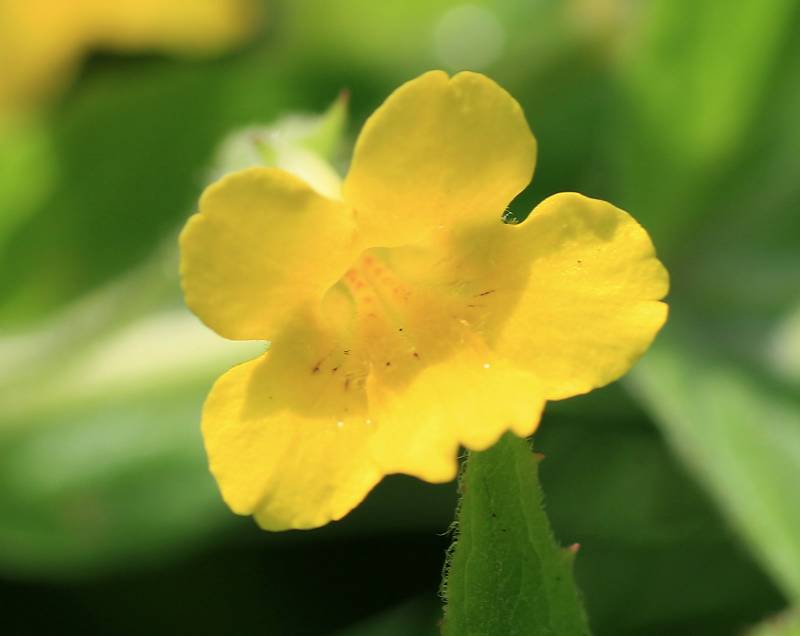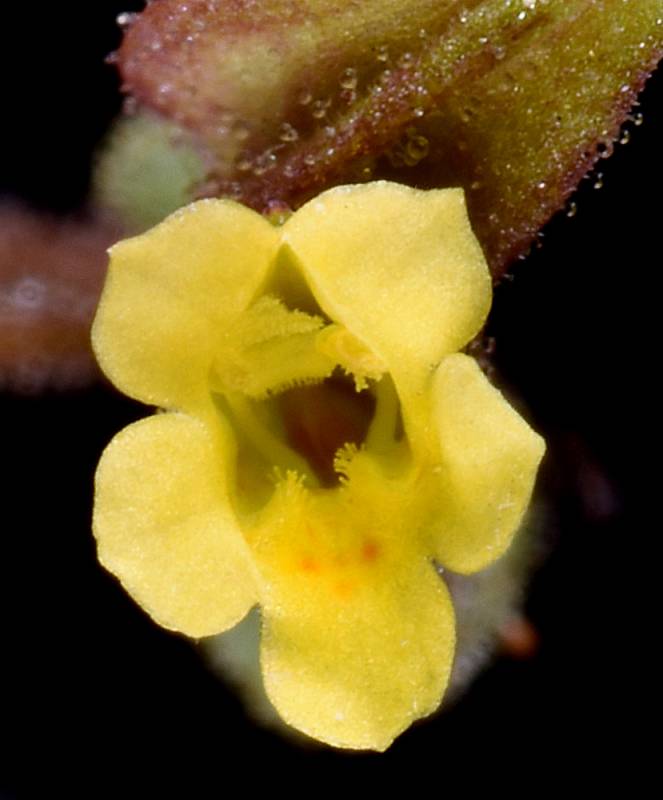Erythranthe ptilota
Erythranthe inflatula
sessile-leaved monkey-flower
disappearing monkey-flower
Leaves cauline, basal ones not persistent, commonly congested; subsessile to sessile;
blade oblong to lanceolate, 30-70 mm long and 10-22 mm broad, pinnate venation, base rounded, margins toothed to finely toothed, apex acute, surfaces hairy as stems.
Leaves mostly cauline, basal leaves generally not persistent by flowering;
petioles 1-3 mm near base, becoming sessile distally;
blade elliptic to lanceolate to narrowly ovate, 8-18 mm long and 3-7 mm broad, mostly evenly sized throughout or somewhat reduced distally, palmate venation with 3-5 veins, base attenuate to obtuse to rounded, margins entire to finely toothed, apex acute to obtuse, surfaces glandular as stems.
Axillary flowers 4-10, emerging from nodes at mid- to ends of stems; fruiting pedicels generally 22-50 mm, hairy as stems;
calyx winged, cylindric-campanulate, barely inflated, 10-12 mm, villous with gland-tipped hairs, lobes spreading noticeably, strongly unequal, linear-lanceolate to slender-triangular, 5-9 mm, apex long acuminate-apiculate;
corollas yellow, throat faintly marked with blackish-brownish lines, symmetric almost radially or weakly bilaterally, nearly regular or weakly bilabiate;
tube-throat slenderly bell-shaped, 15-18 mm, protruding beyond calyx margin;
lobe apex rounded;
styles glabrous;
anthers not protruding, covered with fine hairs that are stiff to slightly rigid.
Axillary flowers 10-20, emerging from mid- to ends of stems; fruiting pedicels not curved or bent, 7-18 mm, glandular as stems;
calyx winged, ridged, maturing to ovoid-ellipsoid to bell-shaped or widely urn-shaped, distinctly inflated, 7-11 mm, margins distinctly toothed or lobed, sparsely covered with minute and rigid hairs, eglandular, lobes pronounced, erect;
corollas yellow to light yellow, with sparse red dots or not, symmetric bilaterally, slightly bilabiate;
tube-throat cylindric, 5-8 mm, protruding 1-3 mm beyond calyx margin;
limb only slightly widened, lobes widely obovate, apex rounded to mucronate;
styles glabrous;
anthers not protruding, glabrous.
Capsules 6-8 mm, included.
Capsules 5-9 mm, included.
Erythranthe ptilota
Erythranthe inflatula
- Local floras:
BC,
CA,
WA
- Local Web sites:
CalFlora,
CalPhotos,
Flora NW,
PNW Herbaria
WildflowerSearch
iNaturalist (observations)
- LBJ Wildflower Center
- SEINet
- Plants of the World Online
- Encyclopedia of Life
- Wikipedia
- Google Image Search
- Local floras:
CA,
OR,
WA
- Local Web sites:
CalFlora,
CalPhotos,
Flora NW,
PNW Herbaria
WildflowerSearch
iNaturalist (observations)
- LBJ Wildflower Center
- SEINet
- Plants of the World Online
- Encyclopedia of Life
- Wikipedia
- Google Image Search



